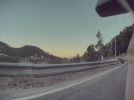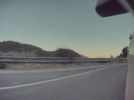A redditor on r/UFOs recently posted footage of an object that flew over a Tesla that was driving from California's Mt Wilson around dusk on Sunday June 25, 2023.
The driver became aware of the object after it stopped some distance ahead of them, but it (along with a second drone) was captured by the car's two rear-facing and one forward facing camera. The driver was then able to save the previous 60 seconds of footage recorded by the Telsa. My understanding of the footage from these cameras is that they are syncronous with one another and all of the calculations assume this.
The redditor's ( /user/ArbiterOfNothing ) post can be found here:
Source: https://www.reddit.com/r/UFOs/comments/14lqnez/multiple_tesla_cams_catch_a_strange_object_moving/
The first video they posted was a montage of clips from the three cameras however they later uploaded the original 60 second files from each of the three cameras here (the drone can be seen around the 30 second mark):
https://drive.google.com/drive/folders/19Q9DIk1Kssa-KkMykM7-9fpp6NFrL-Fd?usp=sharing
The location in the video appears to be near this bend on Mt Wilson Red Box Rd, with the car travelling North-bound:
https://www.google.com/maps/@34.242...WqSnHIXDApAbng-g!2e0!7i16384!8i8192?entry=ttu

Using measurements taken from google maps and timestamps from the videos I am trying to determine the speed of the drone.
The only locations I feel are appropriate to use for judging distance are the trees along the shoulder behind the car seen in the file "Tesla Vid Right.mp4" around the 30s mark. And then the area of the shoulder seen in front of the car in "Tesla Videos.mp4" around the 32s mark.
Google Maps gives a distance of approximately 333 feet between them so I have been using that in the calculations.
Depending on the timestamps used I am getting highly variable results.
Firstly the ending timestamp I think is appropriate is exactly at the 32.0 second mark. It is when the drone first appears ahead of the car and seemingly over / past the shoulder. The drone appears to move more after this point but apparently slowing down. Using timestamps after that feels like recording a runner's time not after they pass the finish line, but instead when they slow to a complete stop.

First appearance of the drone is a small pixel JUST on the very edge of the tree at 30.167 seconds. It isn't clear where the drone is in relation to the reference tree, but doesn't seem like it could be any closer than the tree itself, so this timestamp marks its first possible position. (Note there is another object in the sky, on the left side of the below screenshot. That may be another drone or possibly an airplane, but not the subject of these calculations)

32 seconds ending timestamp - 30.167 starting timestamp = 1.833 seconds of travel duration
It traveled 333 ft in 1.833 seconds or 181 feet per second.
333 feet traveled / 5280 feet per mile * 3600 seconds per hour / 1.833 seconds of travel = 124 MPH
I believe this scenario is wrong (not fast enough), but using the most conservative timestamps provides ~124MPH which is apparently upper mid range for a racing drone. (https://dronesourced.com/guides/how-fast-do-drones-fly/)
This calculation uses the timestamp of when the drone first appears next to the starting tree (however I think is probably approaching the tree from some unknown distance behind, which would increase the distance traveled).
The following image shows the timestamp of 31.194 where the drone appears near the same part of the tree at the same timestamp in both rear views. Is it passing within feet of the top branch? Or is it back farther and above the tree? Or maybe much closer to the car than I am assuming. Possible to triangulate its position?

32 seconds ending timestamp - 31.194 starting timestamp = .806 seconds of travel duration
In this scenario it traveled 333 ft in .806 seconds or 413 feet per second
333 feet traveled / 5280 feet per mile * 3600 seconds per hour / .806 seconds of travel = 282 MPH
Using the most generous starting timestamps the fastest speed is ~282MPH which is faster than the world record of 224MPH set in Jan of this year. ( https://gizmodo.com/ryan-lademann-new-record-for-the-worlds-fastest-drone-1850000565 ). Surely that isnt possible?
Its likely, knowing me, that these numbers are totally wrong or if not, that the true speed is somewhere in between the two. Am hoping to get a second opinion.
I am also wondering if it is possible that the drone is going even faster because the distances used are assuming that the drone is starting from approximately the height / location of the starting tree. I am thinking that someone piloting a racing drone would fly above the trees so to not risk a collision. If the drone is significantly higher than the starting tree, then I am wondering if the starting location might be pushed back? This could significantly change the distance traveled and speed.
The driver became aware of the object after it stopped some distance ahead of them, but it (along with a second drone) was captured by the car's two rear-facing and one forward facing camera. The driver was then able to save the previous 60 seconds of footage recorded by the Telsa. My understanding of the footage from these cameras is that they are syncronous with one another and all of the calculations assume this.
The redditor's ( /user/ArbiterOfNothing ) post can be found here:
Source: https://www.reddit.com/r/UFOs/comments/14lqnez/multiple_tesla_cams_catch_a_strange_object_moving/
The first video they posted was a montage of clips from the three cameras however they later uploaded the original 60 second files from each of the three cameras here (the drone can be seen around the 30 second mark):
https://drive.google.com/drive/folders/19Q9DIk1Kssa-KkMykM7-9fpp6NFrL-Fd?usp=sharing
The location in the video appears to be near this bend on Mt Wilson Red Box Rd, with the car travelling North-bound:
https://www.google.com/maps/@34.242...WqSnHIXDApAbng-g!2e0!7i16384!8i8192?entry=ttu
Using measurements taken from google maps and timestamps from the videos I am trying to determine the speed of the drone.
The only locations I feel are appropriate to use for judging distance are the trees along the shoulder behind the car seen in the file "Tesla Vid Right.mp4" around the 30s mark. And then the area of the shoulder seen in front of the car in "Tesla Videos.mp4" around the 32s mark.
Google Maps gives a distance of approximately 333 feet between them so I have been using that in the calculations.
Depending on the timestamps used I am getting highly variable results.
Firstly the ending timestamp I think is appropriate is exactly at the 32.0 second mark. It is when the drone first appears ahead of the car and seemingly over / past the shoulder. The drone appears to move more after this point but apparently slowing down. Using timestamps after that feels like recording a runner's time not after they pass the finish line, but instead when they slow to a complete stop.
First appearance of the drone is a small pixel JUST on the very edge of the tree at 30.167 seconds. It isn't clear where the drone is in relation to the reference tree, but doesn't seem like it could be any closer than the tree itself, so this timestamp marks its first possible position. (Note there is another object in the sky, on the left side of the below screenshot. That may be another drone or possibly an airplane, but not the subject of these calculations)
32 seconds ending timestamp - 30.167 starting timestamp = 1.833 seconds of travel duration
It traveled 333 ft in 1.833 seconds or 181 feet per second.
333 feet traveled / 5280 feet per mile * 3600 seconds per hour / 1.833 seconds of travel = 124 MPH
I believe this scenario is wrong (not fast enough), but using the most conservative timestamps provides ~124MPH which is apparently upper mid range for a racing drone. (https://dronesourced.com/guides/how-fast-do-drones-fly/)
This calculation uses the timestamp of when the drone first appears next to the starting tree (however I think is probably approaching the tree from some unknown distance behind, which would increase the distance traveled).
The following image shows the timestamp of 31.194 where the drone appears near the same part of the tree at the same timestamp in both rear views. Is it passing within feet of the top branch? Or is it back farther and above the tree? Or maybe much closer to the car than I am assuming. Possible to triangulate its position?
32 seconds ending timestamp - 31.194 starting timestamp = .806 seconds of travel duration
In this scenario it traveled 333 ft in .806 seconds or 413 feet per second
333 feet traveled / 5280 feet per mile * 3600 seconds per hour / .806 seconds of travel = 282 MPH
Using the most generous starting timestamps the fastest speed is ~282MPH which is faster than the world record of 224MPH set in Jan of this year. ( https://gizmodo.com/ryan-lademann-new-record-for-the-worlds-fastest-drone-1850000565 ). Surely that isnt possible?
Its likely, knowing me, that these numbers are totally wrong or if not, that the true speed is somewhere in between the two. Am hoping to get a second opinion.
I am also wondering if it is possible that the drone is going even faster because the distances used are assuming that the drone is starting from approximately the height / location of the starting tree. I am thinking that someone piloting a racing drone would fly above the trees so to not risk a collision. If the drone is significantly higher than the starting tree, then I am wondering if the starting location might be pushed back? This could significantly change the distance traveled and speed.
Last edited:


